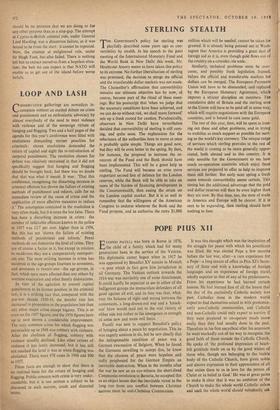LOOP AND LASH
ONSERVATIVE gatherings are nowadays in- k., complete without an excited debate on crime and punishment and an enthusiastic advocacy by almost everybody of the need to meet violence with violence and of the sovereign virtues of hanging and flogging. Two and a half pages of the agenda for this year's conference were filled with resolutions demanding sterner penalties for criminals : eleven resolutions demanded the return of capital and eight the re-introduction of corporal punishment. The resolution chosen for debate was relatively restrained in that it did not specifically suggest that hanging and flogging should be brought back, but there was no doubt that that was what it' meant. It was : 'That this conference, recognising the disturbing increase in criminal offences has shown the failure of existing methods of punishment and reform, calls for an immediate review of the cause of crime and the application of more effective measures to reduce it.' The assumption contained in the resolution is very often made, but it is none the less false. There has been a disturbing increase in crime : the number of indictable offences known to the police in 1957 was 13.7 per cent. higher than in 1956. But this has not 'shown the failure of existing methods of punishment and reform.' Penal methods do not determine the level of crime. They are of course a factor in it, but except in relation to recidivism they are a comparatively unimport- ant one. The most striking increase in crime has occurred in the age-groups fourteen to seventeen, and seventeen to twenty-one—the age-groups, in fact, which were more affected than any others by wartime evacuation and other family dislocations. In view of the agitation to restore capital punishment to its former position in the criminal law, it is a striking fact that, compared with the pre-war decade 1930-39, the murder rate has increased in proportion to the population less than any other major crime except bigamy. This is so even on the 1957 figures, and the 1958 figures have up to now shown a considerable improvement. The only common crime for which flogging was permissible up to 1948 was robbery with violence. After the abolition of flogging, robbery with violence steadily declined. Like other crimes of violence it has lately increased, but it has still not reached the level it was at when flogging was abolished. There were 978 cases in 1948 and 890 in 1957.
These facts are enough to show that there is no rational basis for the return of hanging and flogging. Public concern with crime is very under- standable, but it is too serious a subject to be discussed in such narrow, crude and distorted terms.


































 Previous page
Previous page